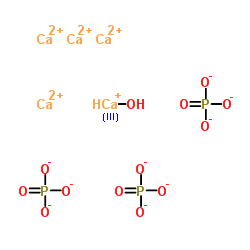Calcium hydroxycalcium(1+) phosphate (4:1:3)

Calcium hydroxycalcium(1+) phosphate (4:1:3) structure
|
Common Name | Calcium hydroxycalcium(1+) phosphate (4:1:3) | ||
|---|---|---|---|---|
| CAS Number | 12167-74-7 | Molecular Weight | 502.31100 | |
| Density | 1.038 g/mL at 25 °C | Boiling Point | 158ºC at 760 mmHg | |
| Molecular Formula | Ca5HO13P3 | Melting Point | 1100 °C(lit.) | |
| MSDS | Chinese USA | Flash Point | N/A | |
Use of Calcium hydroxycalcium(1+) phosphate (4:1:3)Durapatite is also known as hydroxyapatite. It is he mineral component of bones and teeth; it has been used therapeutically as a prosthetic aid and in the prevention and treatment of osteoporosis. |
| Name | calcium phosphate tribasic |
|---|---|
| Synonym | More Synonyms |
| Density | 1.038 g/mL at 25 °C |
|---|---|
| Boiling Point | 158ºC at 760 mmHg |
| Melting Point | 1100 °C(lit.) |
| Molecular Formula | Ca5HO13P3 |
| Molecular Weight | 502.31100 |
| Exact Mass | 501.67600 |
| PSA | 311.24000 |
| LogP | 0.98120 |
| Appearance of Characters | aqueous suspension |
| Personal Protective Equipment | dust mask type N95 (US);Eyeshields;Gloves |
|---|---|
| Hazard Codes | Xi: Irritant; |
| Risk Phrases | R36/37/38 |
| Safety Phrases | S26-S36-S24/25-S22 |
| RIDADR | NONH for all modes of transport |
| WGK Germany | 3 |
| HS Code | 3103900000 |
| HS Code | 3103900000 |
|---|
|
Biofilm community diversity after exposure to 0·4% stannous fluoride gels.
J. Appl. Microbiol. 117(6) , 1798-809, (2014) To test the effect of 0·4% stannous fluoride (SnF2 ) glycerine-based gels on specific portions of the bacterial community in both a clinical observational study and in vitro multispecies plaque-derive... |
|
|
Enhanced enterovirus 71 virus-like particle yield from a new baculovirus design.
Biotechnol. Bioeng. 112 , 2005-15, (2015) Enterovirus 71 (EV71) is responsible for the outbreaks of hand-foot-and-mouth disease in the Asia-Pacific region. To produce the virus-like particle (VLP) vaccine, we previously constructed recombinan... |
|
|
Antibacterial and anti-biofilm activity of mouthrinses containing cetylpyridinium chloride and sodium fluoride.
BMC Microbiol. 15 , 169, (2015) Cetylpyridinium chloride (CPC) and sodium fluoride augment oral hygiene by inactivating bacteria and inhibiting enamel demineralisation, respectively. However, there are few reports in the literature ... |
| APATITE FAP,HEXACLINIC |
| TRI-CALCIUM PHOSPHATE |
| Hydroxyapatite |
| Cellulose hydroxyapatite |
| MFCD00015984 |
| Einecs 235-330-6 |
| Calcium hydroxycalcium(1+) phosphate (4:1:3) |
| CELLULOSE HYDROXYAPATIT |
| EINECS 231-840-8 |
| Calcium hydroxyphosphate,HAp,Hydroxylapatite |
| TERT-CALCIUM PHOSPHATE |
| Calcium hydroxyphosphate,Calcium phosphate tribasic,HAp |
| CALCIUM ORTHOPHOSPHATE |
| Si-HAp |